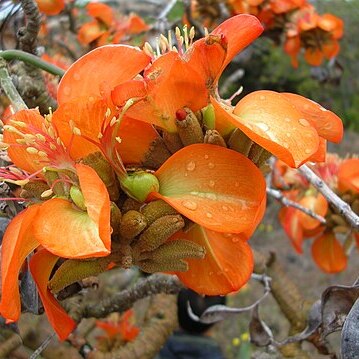Mostly trees or shrubs, rarely perennial herbs (herbaceous resprouters), mostly deciduous, often armed with woody prickles (on trunk and branches; large, woody, conical prickles often on trunk and branches, ordinary prickles sometimes on leaf parts), sometimes with branched hairs; branchlets usually thick. Leaves pinnately trifoliolate, the leaflets usually unequal in size and shape; lateral leaflets usually asymmetrical, slightly smaller than terminal leaflet; stipules small, persistent or caducous; stipels fleshy, usually glandular. Inflorescence terminal or axillary, a many-flowered pseudoraceme (compound racemose), often pyramidal, with groups of few-flowered clusters (flowers in clusters of 2–5); bracts and bracteoles caducous. Flowers often showy, usually shades of red (petals), frequently borne when plant is leafless. Calyx campanulate, tubular or spindle-shaped, apically truncate, spathaceous, obliquely 2-lipped, variously lobed or with 1–5 teeth; tube often split unilaterally at anthesis. Standard mostly far exceeding the other petals, without basal appendages; keel petals free or ± united. Stamens 9+1, lower 9 connate into a tube, alternately longer and shorter, uppermost stamen free or basally connate. Ovary stipitate, pubescent; ovules 2–many (usually numerous); style terminal, incurved, glabrous; stigma small. Pods various, generally linear-oblong, 2-valved, woody or leathery, ± constricted between seeds, dehiscent (or not). Seeds 1–14, usually red or orange. See also Bean (2009: 642).
Trees or shrubs, usually armed. Leaves alternate, pinnately 3-foliate, the leaflets large, the terminal leaflet usually larger than the laterals, the lateral leaflets usually inequilateral; stipels small; stipules minute, caducous. Inflorescence ax-illary or terminal; flowers numerous, disposed laterally in pseudoracemes; pe-duncles usually spineless; pedicels thickened distally. Flowers large; calyx in-equilaterally campanulate or tubular, the margin subentire, lobed or vaguely toothed; standard often large, short or long clawed, thick, greatly exceeding the keel, the keel petals often coherent along the lower margin, apically glabrous; stamens 10, monadelphous or diadelphous with 9 stamens alternating long and short, the anthers versatile; ovary stipitate, fusiform, somewhat curved, the style slender, elongate, incurved, glabrous, the stigma capitate. Legumes stipitate, linear oblong, often moniliform, mostly constricted between the seeds, dehiscent, often twisted at maturity; seeds several, ellipsoidal, colored, the hilum lateral. Erythrina includes about 108 species in tropical and subtropical areas of Old and New Worlds. It is distinguished from other Panamanian Papilionatae by its woody habit, red or orange flowers, by the wing petals being much smaller than the keel, and by the elongate stipe below the ovary.
Trees or shrubs [or perennial herbs], branches with prickles. Leaves pinnately 3-foliolate; stipules small; stipels fleshy and glandular; leaflets sometimes with stellate hairs. Inflorescence axillary or terminal, racemelike, noded, 2-or more flowered. Flowers conspicuous; bracts and bracteoles mostly deciduous. Calyx spathaceous, campanulate, or turbinate, truncate or 2-lobed. Corolla often red or orange, usually longer than calyx; petals extremely unequal; standard large, rounded or oblong, often folded longitudinally, erect or spreading, subsessile or long clawed, without appendages; wings short, sometimes absent; keels much shorter than standard. Stamens diadelphous; vexillary stamen free; anthers uniform. Ovary stipitate; ovules 2 to many; style inflexed; stigma small, terminal. Legume stipitate, mostly linear-oblong, often curved, dehiscent along ventral suture, rarely indehiscent, mostly leathery or woody, often constricted between seeds, not septate. Seeds 1-14, white, gray, or brown, rarely red with dark spots, ovoid; hilum lateral, oblong, without strophiole.
Shrubs, trees, or very rarely herbs. Stems often prickly. Lvs pinnately 3-foliolate; petiolules unequal; stipules simple, small; stipels gland-like. Infl. racemose, axillary and leafless or terminal and leafy at base. Calyx truncate, split or ± 5-toothed; calyx teeth < tube. Keel straight; vexillary stamen free or connate only at base, the remainder connate to 1/2 way; anthers uniform. Style incurved; stigma small, terminal; ovules numerous. Pod linear, falcate, constricted or sinuate between the seeds, 2-valved, follicularly dehiscent by the upper suture, or rarely almost indehiscent. Seeds with an oblong hilum, estrophiolate.
Inflorescences mostly terminal, usually appearing before the new leaves on current or previous year's growth, flowers in 2–several-flowered fascicles; bracts and bracteoles present, sometimes deciduous.
Leaves pinnately 3-foliolate; petiole and leaf rhachis and leaflet veins unarmed or armed with prickles; stipels present, often fleshy or glandular.
Deciduous trees, shrubs or rarely suffrutices; bark usually corky in trees, unarmed or armed with dark prickles often borne on hard woody bosses.
Corolla showy, usually bright red or orange; standard greatly exceeding the other petals, often folded longitudinally, without appendages.
Seeds ovoid, ellipsoid to ellipsoid-oblong, red or orange, sometimes bicoloured; hilum elliptic to oblong, black or white.
Ovary stipitate, hairy; ovules 2–many; style long, incurved, usually glabrous, with a small capitate stigma.
Pods linear-oblong to cylindrical, often constricted between the seeds, usually dehiscent.
Calyx campanulate, bilabiate or spathaceous, the lobes poorly to well developed.
Stamens in a sheath with the vexillary filament free or attached.


